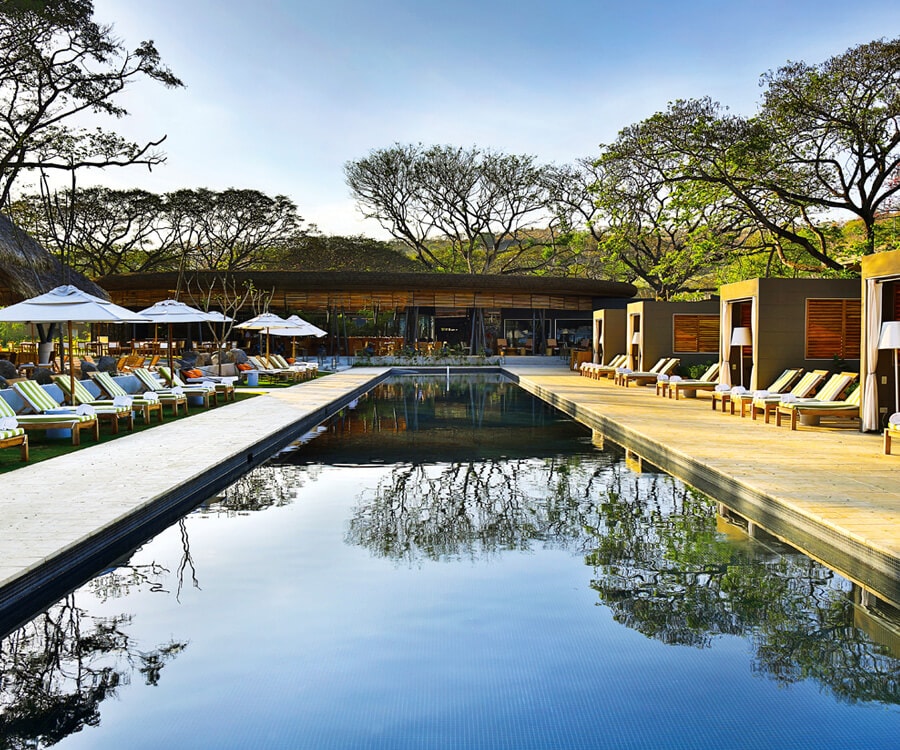
by Kelly | Apr 30, 2018 | Blog
Travelers want a real sense of place when they stay in a hotel, and designers are doing their part to make sure guests feel completely immersed in a destination from the moment they arrive. Here are just a few notable hotels from historic to ultra-modern (and modern twists on historic properties) that are evoking destination in their design.
Yotel
The airline-inspired Yotel brand already has a solid presence in airports and in urban hubs alike. The New York property, opened in 2011, was designed in collaboration by Rockwell Group and Softroom, and blends the airport aesthetic with a distinctly Gotham vibe, starting with the façade – pre-cast concrete surfacing lit with LEDs based on the brand’s logo. The lobby combines a “streamlined and futuristic” look with natural, classic touches. For example, a warm oak canopy covers the central feature of the space – the Yobot, a theatrically-lit robotic baggage drop-off machine. The inner workings of the robot are exposed to create a mechanical performance for the guests as it loads and stores their belongings.
Yotel will open its first conversion hotel later this year in San Francisco. The historic Grant Building was constructed in 1904 and is one of three buildings in the area to survive the city’s infamous 1906 earthquake. Now, it is under construction and is slated to become the 203-guestroom Yotel San Francisco this fall.
Las Alcobas
In Napa Valley, Las Alcobas, a member of Marriott’s Luxury Collection soft brand, opened in mid-2017. The main building in the complex, Acacia House, dates back to 1905 and has been fully restored with a wraparound porch. Encouraging guests to take advantage of the location, the property’s guestrooms have terraces with fireplaces, and 10 have outdoor soaking tubs. Guests can sit outside and look out over the adjacent vineyards, reportedly close enough to smell the grapes on the vines. (Bonus: Guests can get special access to the bottles, making this a great choice for wine lovers.)
The property’s interiors, designed by international firm Yabu Pushelberg, have custom furniture and spa-like bathrooms with soaking tubs and showers, stone-carved sinks, and marble throughout. In-room amenities include local wine and unique “alebrijes” — Mexican folk art sculptures of fantastical creatures (seen in the recent film Coco) that were handcrafted in Mexico City.
El Mangroove
In Costa Rica, El Mangroove is a boutique 85-suite hotel that joined Marriott’s Autograph Collection soft brand in 2016. The resort’s design incorporates natural elements from the country – think local wood and water features, along with bamboo, stone, and natural furnishings that merge all indoor and outdoor spaces. The hotel has a fitness center with outdoor “wild-fit” areas and multi-functional exercise decks.
Hotel Indigo
The 350-room Hotel Indigo Los Angeles Downtown opened last year as a sister property to the larger InterContinental Los Angeles Downtown. Although it is a chain, each property can create its own story and theme. The Los Angeles property celebrates the life and career of Anna May Wong, Hollywood’s first Chinese-American movie star. Much of the artwork at the hotel evokes Wong and 1920s Hollywood. For example, the design on the carpet looks like camera flashes, and old photos are recreated in large scale on the walls. A video installation celebrates the Fiesta de los Flores, a flower-themed parade that used to be held in the area. Other floral artwork can be seen throughout the public spaces, complementing the historic Hollywood elements.
Mayfair Hotel
In downtown Los Angeles, the historic Mayfair Hotel emerged from a major renovation last year that brought the property back to its historic heyday. At nearly a century old, the hotel now evokes its heritage with old maps of the city covering one wall of most guestrooms and preserved historic elements in the public spaces. Designer Gulla Jonsdottir recreated the look of the hotel’s original ceiling with a new chandelier that casts upwards shadows with the original pattern. Most of the lobby’s custom-made furniture is a mix of antique and new.
Whether a hotel is historic or new, there are plenty of ways to evoke a destination in its design, from small touches to the whole architecture. It’s never too late to update a property’s look with some local inspiration, and even the smallest details can have a big impact on a guest’s experie
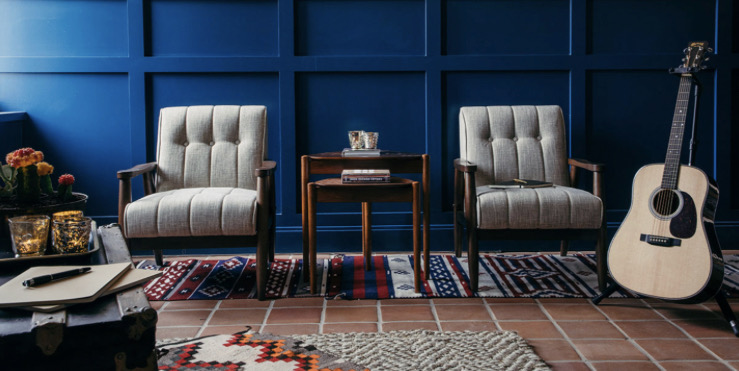
by Kelly | Apr 2, 2018 | Blog
Today’s travelers aren’t interested in cookie-cutter hotels. When they’re on the road, they want to feel like they are truly in a destination. Whether or not a hotel must adhere to brand standards or a certain budget, there are plenty of ways to bring a bit of the community into the space. Here are a few examples of what different hotels, both branded and independent, have been doing to make sure guests get a true sense of place.
The Living Stage
Red Lion Hotels’ upscale boutique brand Hotel RL has a dedicated platform for local artists. The “Living Stage” hosts a wide range of performances and interactive activities – from public speakers to musical performances to hands-on demonstrations. In March alone, Hotel Rl Baltimore Inner Harbor hosted a painting event with local visual artist Kris Diggs, Hotel RL Spokane at the Park hosted local writer Kate Poitevin, and the Olyimprov team performed at the Hotel RL Olympia. Because there’s always something different on any given day, guests and locals alike can come back and see something new and interesting.
Cultural Education
Classes are a great way for guests to learn more about the area, especially if many of them are international. On Mexico’s Yucatan peninsula, the wellness-focused Chablé Resort & Spa hosts classes on Mayan cuisine where participants make their own tortillas from fresh corn as well as peel and roast local chilies to make salsas. The resort’s Temazcal Ceremony recreates the traditional Mesoamerican version of a sweat lodge, part of a curative ceremony thought to purify the body after exertion, to heal the sick, and improve general health. The ceremony is guided by a local shaman.
Rooms for Writers
In Miami, The Betsy-South Beach emphasizes arts and culture in its programing, displaying work from local and global artists, hosting musicians, and bringing in thought leaders to talk about their expertise with guests. Thanks to a dedicated “Writers’ Room” that offers residencies to up-and-coming wordsmiths, the hotel also hosts poetry readings and meet-and-greets with the writers.
In Nashville, guests can get a taste of the city’s powerful music scene in the Hutton Hotel’s two “Writers’ Rooms,” where guests can play custom Martin guitars in the vocal booth. Artist-selected custom Gibson guitars and an antique writer’s desk invite guests to compose their own songs and write their own lyrics. Each room has modern and retro-style gear ranging from premium tube amps to handcrafted microphones. A “Pic Jar” encourages guest artists to snap a photo and leave it behind for the next aspiring musician to find.
Visual Art
Technology is making it easier for hotels to display local artwork. San Francisco-based Daylighted partners with artists, galleries, museums, and other associations to bring artwork to large and small screens alike, anywhere in the world. Hotels can display a curated collection of work from local and global artists on large screens in public spaces or in guestrooms, rotating the images as needed. Best of all, guests can easily purchase any pieces that they like with a few clicks. Daylighted has curated artwork for Marriott, Sofitel, and Hyatt properties, among others.
There are also low-tech ways for hotels to promote local artists. The upcoming boutique Sophy Hyde Park in Chicago has partnered with Hyde Park Academy High School to install an exterior mural as an outdoor art gallery in front of the under-construction building. The mural will serve as a fixed exhibition wall that will remain on view throughout the construction phase, displaying 60 original works of art by the young art students.
What You Can Do
While not every hotel can have a full theater or be attached to a museum, these examples can help any property give its guests a taste of local flavor. A hotel lobby can easily become an art gallery for local talent (contact nearby art schools to see what’s available nearby), and rotating artwork makes sure that repeat guests always have something new to see. A digital display can be an eye-catching way to show off the work of numerous artists at once, and to help connect the artists with potential buyers.
Even hotels with small footprints can host musical acts for guests and locals. Lobbies (and lobby bars) are a perfect venue for area musicians to entertain guests while they socialize in the evening. In good weather, set up a space outside and encourage guests to linger by a fire pit and listen to the music (and, of course, order a few drinks). The bands will value the opportunity to build up a fan base, the guests will appreciate the music, and everyone will leave happy. Best of all, the guests will have had an experience that they could not have had anywhere else.
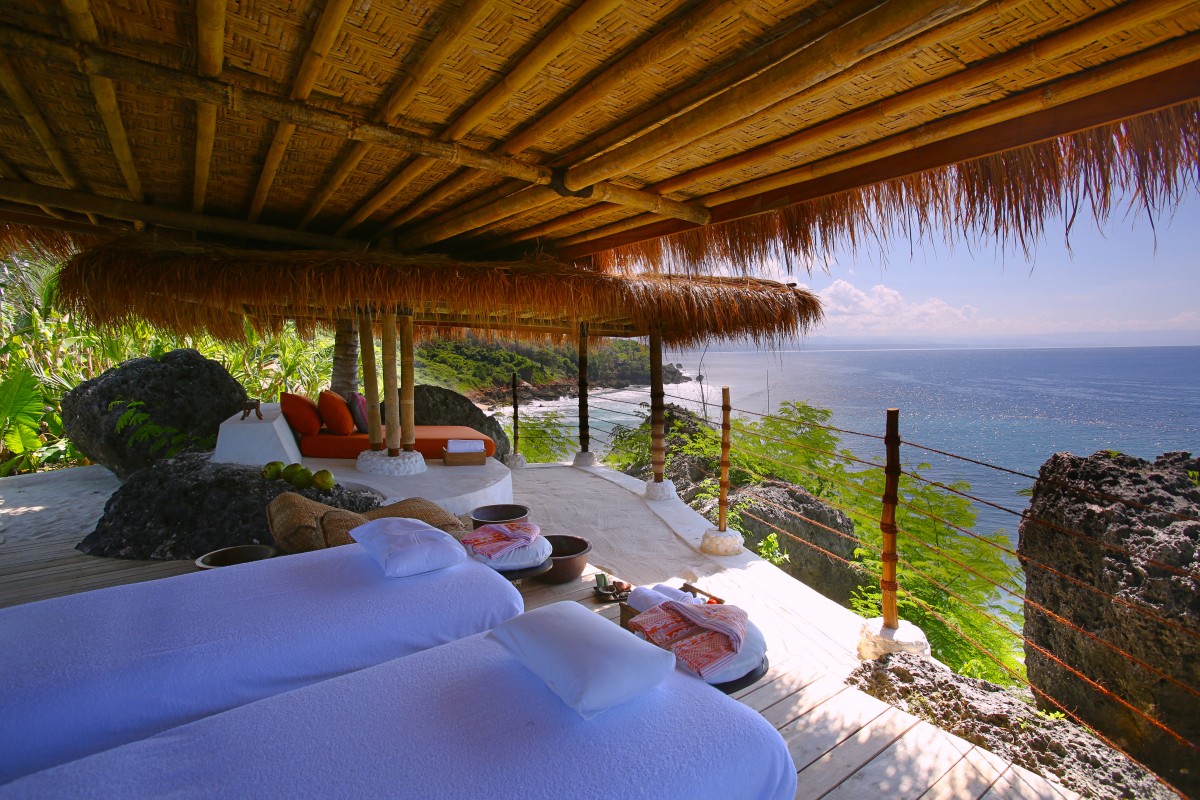
by Kelly | Mar 1, 2018 | Blog
In the travel industry, wellness is more valuable than ever. People are living healthier lifestyles, and they don’t want to give that up when they’re on the road. According to the Global Wellness Institute, travelers are set to spend more than $800 billion on health-focused trips by 2020.
Health-focused resorts around the world are finding exciting new ways to capitalize on this growing demand, and paving the way for smaller properties to enhance their own wellness offerings.
The Global Wellness Summit recently released several studies including “A New Era of Transformative Wellness Travel” which reported that destinations are creating “necklaces” of linked experiences that cater to physical, emotional, and mental well-being. “Spas have long adopted the language of the ‘journey’ but with little actual journeying; now concepts are appearing befitting the term,” the report said.
These excursions can involve a single day or weeks, depending on what guests need and want. A day-long excursion can include visiting a local market, an al fresco meditation session, and a full afternoon of spa sessions. For example, at the Nihi Sumba Island resort in Indonesia, the NihiOka Spa Safari takes small groups for an early morning hike to a traditional village where they can meet locals, and later to open-air platforms suspended over the ocean to enjoy their meals. Later in the day, there’s unlimited spa treatments, swimming in the pool, and relaxing on the beach. Because the treatments are unlimited, there’s no stress of clock-watching.
This year, Bhutan is getting ready to launch the first “multi-lodge wellness circuit.” The Six Senses Bhutan will have five lodges dedicated to everything from design to food to spa experiences. Guests will go on a literal and metaphorical journey across different landscapes, climate zones, and cultural areas. As they travel across the five lodges, they will collect charms to add to a bracelet, marking their progress as they learn about the different elements of wellness.
“People want far more immersive journeys and experiences, particularly wellness travelers: those transformative epiphanies that come from stepping into a story larger than themselves,” Anna Bjurstam, VP of Spas & Wellness at Six Senses, said in the report.
What You Can Do
While huge resorts have the space to develop expansive offerings to improve guest wellness, smaller hotels in urban and suburban areas can use the same idea on a smaller scale, using effective programming and good partnerships to create their own experiences. For example, a hotel can organize yoga or meditation sessions in any outdoor space – deep breathing in fresh air will help guests relax quickly. A local trainer can come in to host dedicated fitness classes in the gym during certain hours or on certain days. If a hotel doesn’t have a spa, it can partner with an establishment nearby and offer to shuttle guests to and from their sessions so they don’t need to worry about driving.
Hotels can also partner with walking tour groups or individual guides to give guests an in-depth look at the community. Bring guests to local markets that sell food or artwork, and give them a chance to get to know the people in the area. Local artists also make for good partnerships – invite musicians to play in the lobby or in the courtyard to help get guests relaxed and calm after, or perhaps before, a long day.
Healthy food should already be available, whether the hotel has a full restaurant or only limited F&B options. Infused water and fresh fruit are absolute musts, but don’t forget herbal teas. Whether the guests are just unwinding for the day or taking a deeper dive into their wellness, they’ll appreciate the small touches that help them on their journey.
Keep in mind, the programming doesn’t have to be as intricate as that offered by Six Senses or the NihiOka Spa Safari, but it can still promote health and wellness on a smaller scale. The important thing is to have your guests leaving feeling better than when they arrived, and that will make them want to return.

by Kelly | Jan 31, 2018 | Blog
The days of sad, lonely, hidden-away hotel bars are long gone. Today, hotels are turning their bars into community watering holes, encouraging locals and guests alike to mix and mingle and providing a literal taste of the destination with local fare and libations.
With savvy design (and top mixologists behind the counter), midscale and upscale hotels alike are finding new ways to bring in foot traffic and increase revenue at the same time. It’s no surprise that when The World’s 50 Bars published its list for 2017, five of the top 10 were located in hotels, including the top four on the list.
The New Lobby
Marriott’s new millennial-focused Moxy brand is a prime example of this trend: Rather than a traditional front desk, arriving guests get a complimentary drink at the bar, where they are encouraged to socialize before and after heading to their rooms. The brand’s development team has called Moxy “a bar with rooms upstairs,” and the hotels target young travelers who want to socialize over drinks rather than stay in their rooms. TripAdvisor reviews of Moxy hotels frequently mention the quirky and memorable bars, which is a good sign that they are catching the eye of the target demographic.
In 2016, the Hilton San Francisco Union Square spent $6 million of a $25-million renovation on updating the hotel’s 30,000-square-foot lobby. The lobby bar got a major overhaul as well, and according to Senior Marketing Manager Alex Lopez, the efforts have paid off.
“It’s a welcoming meeting spot,” Lopez said of the lobby bar after nearly two years of business. “It’s kind of a central hub in downtown San Francisco, a really energized spot where both locals and guests meet and greet.” The hotel’s popularity for meetings and events brings in plenty of foot traffic, and the bar’s services keeps guests from seeking food and drink elsewhere.
Hotel lobby bars are replicating what a lot of popular bars are doing, Lopez said, mentioning craft cocktail service that highlights local flavors and ingredients that are sourced from nearby vendors. Beyond the rotating cocktail menu, the lobby bar has a selection of regional wines and beers for a true taste of the destination.
At the Freehand Hotel in downtown L.A., Rudolph’s Bar & Tea takes the idea even further: the special cocktails all involve tea, catering to yet another trend. It also offers a traditional tea service as well as light bites for those who would prefer something a bit less intoxicating, which is a good way to bring in yet another demographic.
The Speakeasies
While lobby bars are broadening their appeal and attracting foot traffic, other hotel bars are emphasizing exclusivity. The growing trend of modern speakeasies has hit hotels, and hidden niches are turning into chic hotspots for those in the know.
In contrast to a lobby bar, a speakeasy should be kept out-of-view from the general public. According to David Shove-Brown, partner at Washington, DC-based design firm //3877, the best spaces are leftover niches, and they should remain under-designed rather than over-thought.
“If you look at the history of the speakeasy, it was a back-alley space with a collection of random furniture, and dimly lit,” Shove-Brown said. “Instead of over-lighting and over-designing, a speakeasy should be a simple design with some tables and interesting bar seats that create little nooks and niches.”
Benjamin Cooper, tucked inside the Hotel G in San Francisco, perfectly captures this understated style with an eclectic mix of turn-of-century ornateness and mid-century bric-a-brac. The menu has weekly cocktail specials and oysters that draws a loyal crowd.
The new W Bellevue, which opened over the summer in Washington State, has a speakeasy lounge with a decidedly Prohibition-era flair. Accessed behind a reclaimed wood staircase in the lounge, Civility & Unrest has plenty of curves and plush seating and a hidden room for real privacy. James Beard Award-winning chef Jason Wilson is behind the menu, which includes spirits from local craft distillers and regional microbrews.
Visitors to the Montage Beverly Hills, meanwhile, must ask a staff member to guide them through the kitchen and off-limits stairways and corridors in order to reach £10, a hidden space that specializes in single malt scotch. The room is decidedly upscale, with plenty of velvet and dark wood, and a patio that overlooks the garden outside. (No good trying to sneak in here: The entrance really is behind-the-scenes, and guests have to be escorted in.) In an interview with Locale Magazine, £10’s bartender estimated that only 10 percent or so of the bar’s guests come from the hotel. Most are locals who appreciate the swank ambiance and exclusive vibe.
In New York City, Lantern’s Keep is a notable jewel in the theater district. Tucked away inside the chic Iroquois Hotel in midtown, Lantern’s Keep is a Belle Époque salon outfitted with marble tables and paintings of ballerinas on the rich, dark-wood walls.
There are no limits to what a creative hotelier can do with a bar. With a comfortable vibe and quality options behind the counter (and a careful eye on niches and trends), a great in-house bar can keep the guests from going out to spend their money elsewhere, and can bring the locals in to make the experience authentic and fun for everyone.
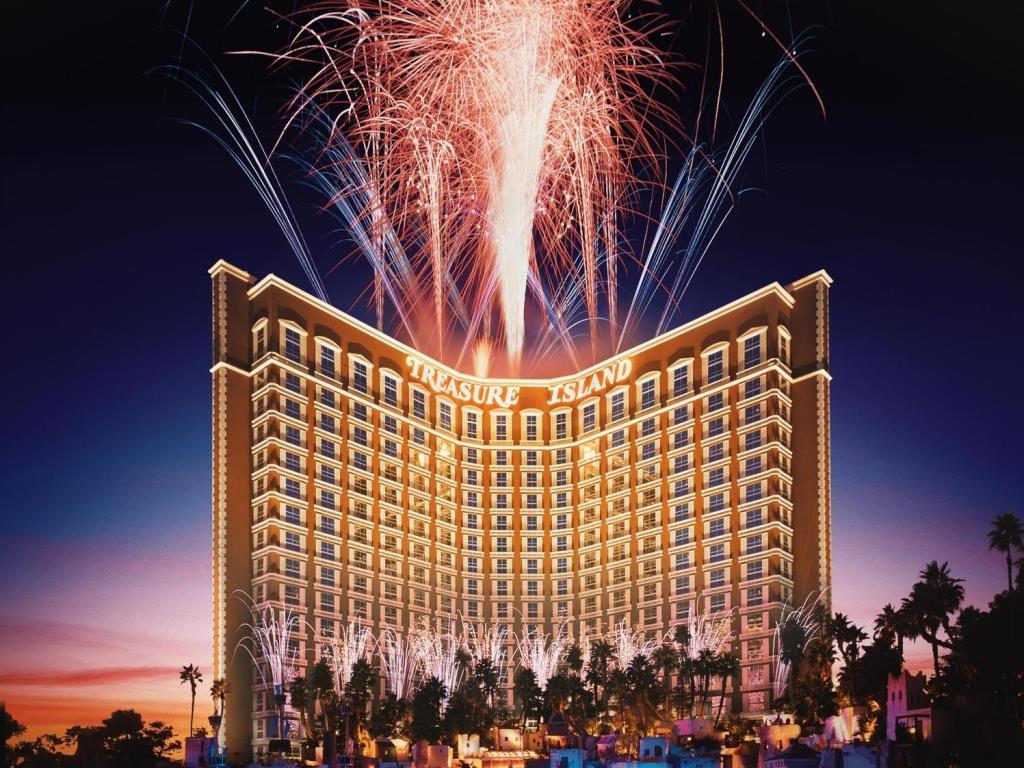
by Kelly | Jan 11, 2018 | Blog
Hoteliers, the New Year is a great chance to make some changes on how you run your property. If you’re looking for some new ideas or inspiration for 2018, here are some resolutions you can make now that can have big payoffs by next December.
- Enhance Your Website
A good website will do so much more than show off pictures of your hotel. New technology makes connecting with potential guests easier than ever. From the moment they land on your website, you can start communicating through a chat program like Provide Support, MeOkay, or LiveChat – answering questions, fielding requests and giving a personal touch. Once the conversation is underway, securing a reservation becomes much easier.
You should have a booking widget on every page of the site so that guests can start to make a reservation no matter where they’re looking. (Don’t include a “cancel” button on the widget until the final confirmation page. If they don’t see the word “cancel,” they’ll be less likely to think about doing so.)
A video background can be a great way to catch a potential guest’s eye and keep them on the site longer, improving the chances of a booking. Take a look at the websites for White Lodging and the Hotel G in San Francisco – the brief videos in the background give a taste of what the guest can expect inside and out when they arrive. (Tip: Don’t cover the video with too much text. Let the visitors scroll down if they want to read more.) If video doesn’t feel right for your hotel, consider a slideshow for a similar effect.
Want to take it a step further? Virtual reality and 360-degree photos are great ways to really show off what your hotel can offer. The luxury Jumeirah brand has a full immersive VR tour of the Burj al Arab that lets visitors to its website see the hotel’s public spaces and guest rooms as though they were there. (Visit inside.jumeirah.com.)
If a major VR addition to your website seems too much to launch right now, start small. 360-degree cameras are very affordable these days, so you can begin with just a few videos and photos and grow from there. It’s a good idea to emphasize your event spaces here: Planners are much more likely to book a ballroom when they can virtually stand inside it and look all around.
If you have a lot of events at your hotel, embed a video or 360-degree pictures that will let potential planners see what cool lighting effects you can create, and all the different ways the spaces can be configured. Walkthroughs of the public spaces and guest rooms will whet potential guests’ appetite and convince them that your hotel is the one they want. A company like PhotoWeb can help take professional 360-degree VR photos and set up virtual tours on your website.
- Boost Your Social Media Presence
Does your hotel have a Twitter account? What about Instagram? Every social media platform gives you access to whole new demographics, and each account you use lets you connect with new potential guests.
Your hotel should have a presence on Facebook, Instagram, and Twitter at the very least. Set aside time each day to reach out to potential guests, answer any questions and respond to any comments previous (or current) guests may have shared on all of the platforms. This not only will help you attract new business, it will also keep guests coming back if they feel that you take their concerns seriously.
If this seems daunting, you can also hire a social media professional to help out. This can be a part time position or even an internship role, so the expense doesn’t have to be substantial. The rewards, however, will be.
- Check Out Your Online Security
From the smallest independent boutiques to the largest global companies with dozens of brands, hackers are getting into hotel computer systems, leaving guest information vulnerable.
You don’t want guests to associate a stay at your hotel with having to get new credit cards or trying to fix identity theft, so make sure you have the best security system in place that you can afford, and that everyone on the hotel team who has access to the computers knows how to keep private information safe.
Hotels are finding lots of solutions for this challenge: Treasure Island Las Vegas, for example, is using b4easypost, an online payment and posting software solution designed to protect credit card information, through a partnership with Agilysys and cloud-based hospitality software developer b4checkin.
You can also use a tokenization system to protect guest data during credit card transactions. For example, First Data is providing tokenization services for AccorHotels worldwide, while G6 Hospitality, the company behind Motel 6 and Studio 6, is using FreedomPay for the same service.
- Review Your On-Site Security
Several hotel brands are rolling out new types of locks that let guests open the doors to their rooms with an app on their smartphones. Guests can even bypass checking in at the front desk in some cases—which may be very convenient for people in a rush, but it makes it harder for the hotel team to know who should be heading to the guest floors and who doesn’t belong there. If your hotel is incorporating this type of technology, encourage your team to be very observant, and to report anything unusual. If a front desk agent or a housekeeper expresses any concern, be sure you know what you are legally able to do about it.
Security also has to apply to making sure everyone on your team feels secure. Encourage regular discussion at staff meetings to make sure everyone is on the same page in terms of harassment guidelines, and that they know they can come to you with any concerns about inappropriate behavior from guests or coworkers.
- Do A (very) Soft Renovation
A soft renovation doesn’t have to be expensive or very time-consuming. Some new curtains and fresh duvet covers can make a world of difference, and can boost a room’s appeal in minutes.
You can also add a bit of greenery to your hotel, with some larger plants in the public spaces and small ones in the guestrooms. Studies are proving that guests like seeing some elements of nature in their hotel, and that they’re willing to pay more to be close to something green. (If you can’t add plants to the public spaces or guestrooms, look for artwork that includes pictures of nature. It makes a difference!)
If you use LVT or carpet tiles on your floors, consider retiring some worn-out pieces in favor of some remnants that you’ve kept in storage. It can give a space a cleaner, fresher look without costing a fortune or taking much time.
2018 is a fresh start for you and your hotel, and a good excuse to make all those updates you’ve been thinking about. Make the most of it, and have a very healthy and happy New Year!
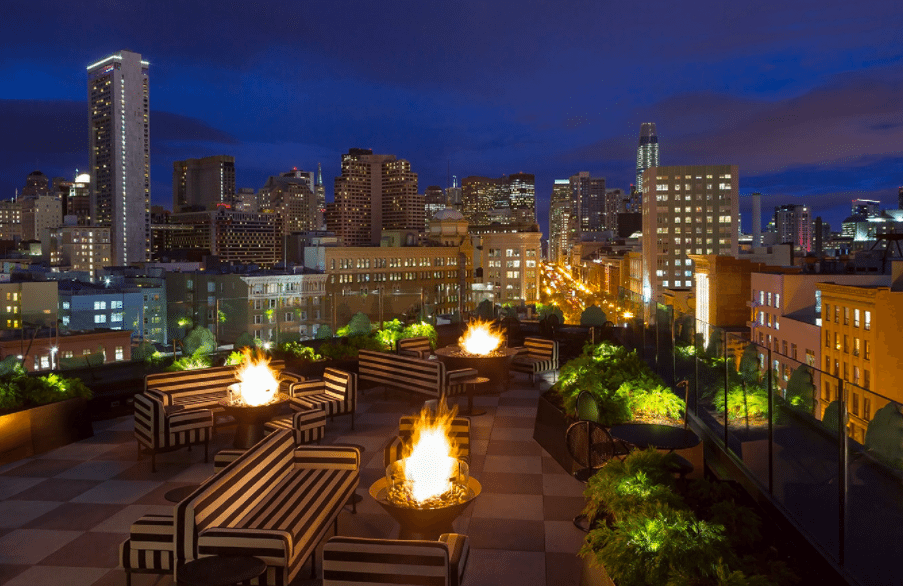
by Kelly | Dec 5, 2017 | Blog
A hotel’s rooftop used to be just that – a rooftop, and in terms of revenue, wasted space. Not any longer. Hotels are getting more creative and transforming outdoor areas into immersive experiences that not only offer additional amenities for guests, but also generate serious income. What’s more, outside spaces are becoming just as important to attracting guests as their interior counterparts.
There are lots of ways to create an effective outdoor space that will be both popular and profitable. Here are some of our favorite options that guests love.
Maximize Your View
Getting fresh air at city hotels used to be challenging but not anymore. Many hotels are adding rooftop lounges that provide a high-altitude, high-end experience with top views of the surrounding areas.
In San Francisco, the 12-story Hotel VIA has an expansive rooftop lounge with vistas of the city’s skyline, and is directly across the street from AT&T Park, home to the Giants and top-tier concerts in the off-season. Guests at the lounge can cozy up around fire pits with a drink from the bar or reserve their own private cabana. Another top San Francisco rooftop spot is Charmaine’s at the newly opened Proper Hotel, a bar and lounge soaring 120 feet above bustling Market Street.
Beyond lounges and bars, rooftops continue to evolve in intriguing new directions adding pools, herb gardens, and even movie theaters. (Imagine watching Star Wars under actual stars!) Every inch is precious in an urban hotel, so hoteliers should carefully consider the best use of any available rooftop space.
Add Some Fire
Several extended-stay hotels such as The Westin Ka’anapali Ocean Resort Villas in Maui supply outdoor grills for guests to cook their own al fresco dinner and socialize. The grills are a good investment for long-term guests, especially if the hotel also makes available a grocery delivery program for guests to order ingredients before arrival (for a fee, of course). If guests know they can grill a steak to their liking without having to head into town and pay restaurant prices, they may be more likely to order one from the hotel itself. And if a family can linger outside around the grill like they do at home, even better.
Beyond grills, fire pits have long been popular social hubs at hotels, extending the lobby outdoors and encouraging guests to stay outside longer year-round, and order more from the bar while they relax.
Incorporate Nature
For hotels with a larger footprint – generally those away from urban hubs – a garden can be more than just a pretty collection of flowers. Hoteliers can get creative by utilizing the space for dining, meetings, and weddings, generating extra revenue for the hotel, and providing a unique space where guests can enjoy the surrounding outdoors.
The Ojai Valley Inn’s Hacienda Courtyard and Artist Cottage Lawn has some top views of the Topatopa Mountains and Ojai Valley. The property also grows lavender and 65 herbs, and has 20 types of fruit trees on its hillside orchard. As a bonus, for al fresco events, the space can hold up to 60 guests, while the adjacent lawn and vine-covered pergola can accommodate up to 200 guests.
Even small boutique hotels can offer outdoor space for guests. When it opens next fall, the 39-room The SLO-Hotel San Luis Obispo will have a huge pool terrace and an adjacent garden courtyard. The property will also have an exclusive rooftop event space and an adjoining terrace with fire pits.
Create a Quiet Enclave
Some hotels keep their outdoor space semi-enclosed, which can be a good option in areas with lots of ambient noise, like close to a highway or an airport. The design-forward AC Hotel San Francisco Airport/Oyster Point Waterfront is built around a central courtyard, for example, where guests can sit outside with their drinks or rent the space to host events.
Ultimately, every hotelier can find unique ways to make the most of a hotel’s outdoor spaces. Whether it’s putting a lounge on a rooftop or creating a garden for escaping the rest of the world, guests will appreciate an opportunity to be outside and to get some fresh air.

by Kelly | Nov 6, 2017 | Blog
Here’s an exchange a traveler recently shared on Twitter, recounting a quick but memorable check-in experience at a major branded hotel:
Me: I’m checking in
Him: Long day?
Me: Too long
Him: Here’s a voucher for the bar.
Yes, building loyalty can be that simple. Whether a property is branded, independent, large or small, a hotelier can make a guest’s stay a lot more memorable by anticipating their needs and personalizing the experience. And once a guest has had a positive experience, they’ll be much more likely to share that story on TripAdvisor, Yelp and other review sites. (For the record, the traveler in the above exchange made a point of tagging the hotel brand in the tweet.)
Offer the Unexpected
Making a guest’s stay memorable enough to be shared on social media doesn’t always have to be a huge gesture. Front desk agents should put themselves in the guest’s shoes and imagine what they would want in the guest’s situation.
If a hotel doesn’t have a bar where a weary guest can get a late-night refreshment, the front desk agent can offer a voucher for the grab-and-go stand, or deliver some fruit from the kitchen. Hospitality is more than just food, of course: A hotel can also keep a few umbrellas by the front desk for the staff to hand out in case of unexpected rain. The cost to the hotel will be minimal, however guests will appreciate knowing that the hotel team cared enough to keep them dry, or make sure they had something to eat before bed.
In his book Zombie Loyalists, entrepreneur and speaker Peter Shankman shared a story of his stay at The Ritz-Carlton, Dubai several years back. Upon returning to his room late one night, he found a fresh miniature tube of toothpaste in the bathroom with a note from the housekeeper. She had noticed that he was out of toothpaste, and took it upon herself to get him some more.
The gesture so impressed him that he shared the story on his social media platforms. As he wrote in Zombie Loyalists: “My social networks blew up, and the brand awareness of the amazing service at The Ritz-Carlton shot up a little bit as well. I personally know two people who made reservations at this specific hotel when they traveled to Dubai in the following months, and they both said this picture was what pushed them over the edge to do it. Cost to the hotel? Probably about 48 cents. Result? Well, let’s just say reservations at The Ritz-Carlton, Dubai aren’t cheap. How’s that for some customer service ROI?”
Empower Employees
There’s another important element to the bar voucher story: The front desk agent didn’t stop to get approval from management before giving the guest the voucher. When hotel employees are empowered to make quick decisions, they can make a guest’s stay better and solve potential problems much faster.
The housekeeper at The Ritz-Carlton, Dubai knew that she could bring Peter Shankman some toothpaste because the brand allows every employee to charge more than $1,000 each day in order to improve any guest’s experience. That means that a busboy overhearing a complaint during breakfast can quickly have a complimentary bottle of champagne sent to a guest’s room, all without having to authorize the expense with upper management.
Of course, not every hotel can allow its staff charge $1,000 per day, but the principle is the same, even at lower price points. Empowered team members will find meaningful ways to make a guest’s stay better, and when guests are surprised and impressed, they are much more likely to share the story and encourage more people to make reservations.
Encourage Interaction
Soon after the guest has checked out, the management team should be sure to follow up and request any feedback the guest might want to share. Most importantly, make it easy for them to share that story by including links to the property’s TripAdvisor and Yelp pages in the correspondence. Once they’ve been wowed with a great experience, they’ll have a great story to share that will encourage more guests to book a stay.
TripAdvisor also offers several tools to encourage interaction with guests such as Review Express, a tool that allows hoteliers to create and send emails encouraging guests to share their stories. TripAdvisor also has widgets for hotel websites and an app for hotel Facebook pages.
Connecting with guests is vital these days, and it’s vital for employees to feel empowered by management to make every guest’s experience positive. Also by following up after the stay, a hotel can see its online reputation grow and experience an uptick in reservations going forward. As in life, it’s the small things that matter most.
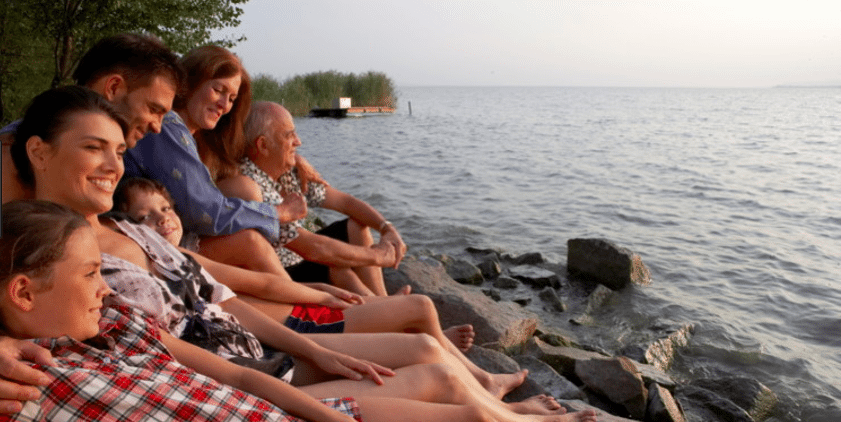
by Kelly | Oct 3, 2017 | Blog
Why is every hotel trying to attract millennials these days? They aren’t the only powerful demographic out there, and hotels shouldn’t necessarily try to appeal to every generation. Here are some tips that will help hoteliers catch the eye of both Generation X and the baby boomers, and keep them coming back with their families.
Baby Boomers
These days, many baby boomers have retired and are eager to see the world. According to AARP, 99% of baby boomers planned to take at least one leisure trip in 2017, with an average of five or more excursions expected throughout the year. They are looking for relaxing vacations that give them a chance to connect with friends and family, so when factoring in the number of multi-generational trips they’re likely to organize with extended family, this makes the demographic very lucrative.
In general, boomers are not impressed by the minimalism popping up in many new hotel brands. Instead, they’re seeking familiarity and comfort in their hotels, so the ultra-hip open-plan guestrooms without closets and few perks are likely to elicit arched eyebrows. When they travel with their families, they want adjoining rooms with connecting doors, making it easy for kids, parents and grandparents to stay together.
Connecting with boomers is not all that different from connecting with the younger generations. A full 41% of boomers book flights, cars and hotels online, and most are members of a loyalty program. But while many brands use social media to promote their properties and communicate online with millennials and Gen Xers, this may not be as efficient for boomers, who prefer to talk with real people and want to reach a human being when they contact the front desk.
There’s another reason why hotels should reach out to boomers: according to AARP, only 18% said they wanted to stay with locals, giving hotels a big leg up over Airbnb and other home-sharing sites for this generation.
Generation X
Generation X is the “middle child” in between boomers and millennials, and the travel trends of this demographic have elements of both generations on either side.
The children of the boomers are now the heads of companies, and are a dominant force in business travel. When they’re on the road for their jobs or for fun, they want plenty of comfort, and they’re willing to pay for it.
A Virtuoso study into generational travel differences last year found that Gen X spends the most of any generation each day while on a trip, at $627, and MMGY Global found that Gen Xers planned to spend an average of $4,517 on vacation in 2017, up 10% from 2015. In other words, this generation is also lucrative.
The most important Gen X factor when choosing a hotel is location, the Gallup study found, with room rate and overall quality following up. Services are also highly valued, and good wifi is a must. Notably, Gallup found that these factors outrank a hotel’s brand for Generation X, with only one in five travelers from the demographic claiming a strong emotional attachment to a brand. This, of course, gives independent hotels a chance to shine.
Like boomers, Gen Xers like family trips so large adjoining rooms are in demand. A dedicated kids club is popular for families with younger children, but if that isn’t available, even a pool or small playground can attract a family away from the competition. They also like to travel for celebrations – a graduation, for example, or a bachelorette party. As such, hotels that offer group rates and have a good restaurant or bar will catch their eye.
Much like millennials, Gen Xers value experiences and authenticity when they travel. A hotel with a design that reflects its location and that offers good access to local attractions (a shuttle to a trendy shopping area or a beach, for example) will be appreciated.
While no hotel can please every individual, knowing what different generations of travelers are likely to want will help a hotel attract that generation’s business.
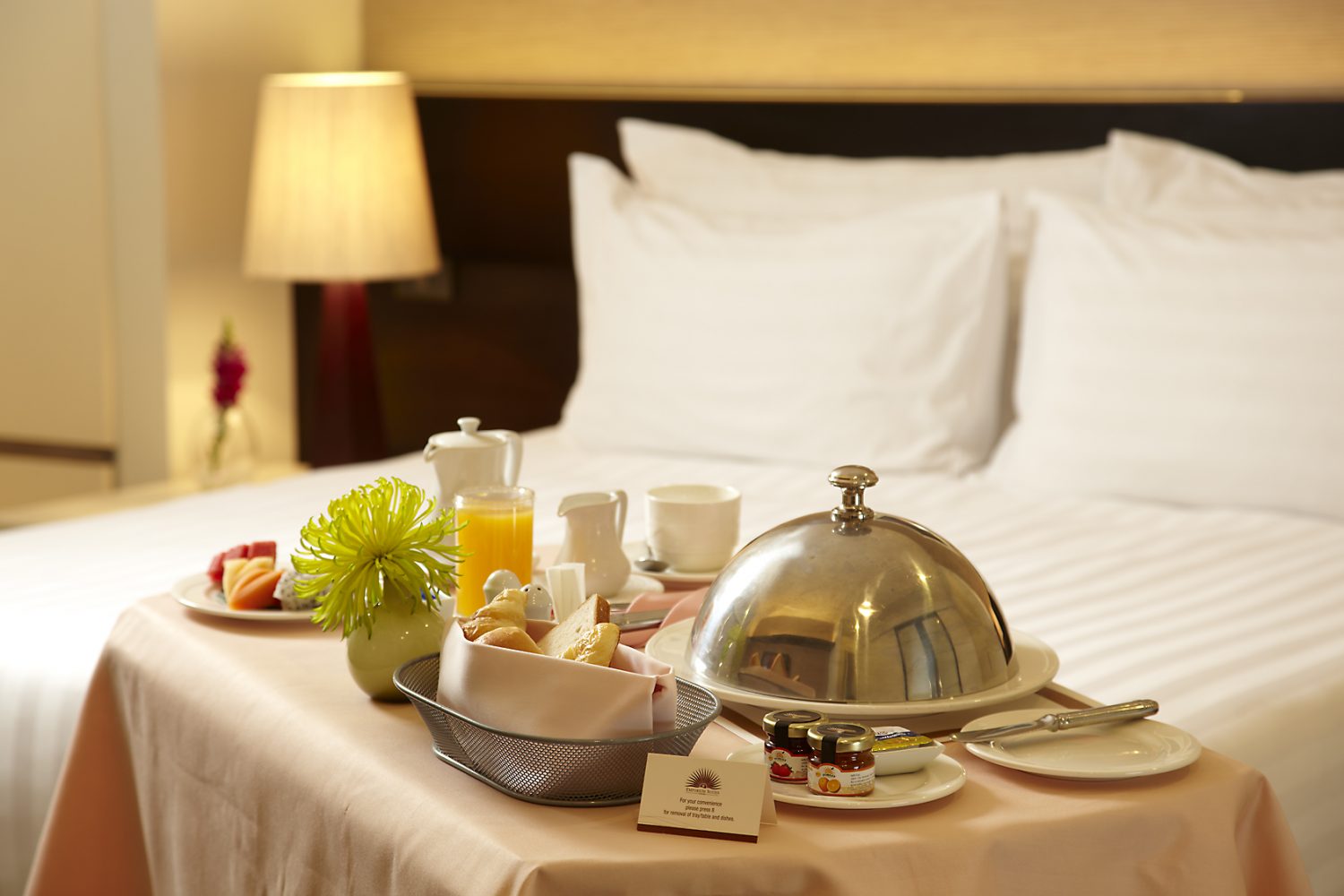
by Kelly | Sep 7, 2017 | Blog
Not yet, but it seems to be on the way out. While plenty of hotels still offer traditional room service, guests’ tastes are evolving, and food and beverage programs must change to suit new demands. Many hotels are limiting costly room service, or completely scrapping it in favor of new F&B concepts that give guests more convenience at lower prices, plus opportunities to experience local fare.
Hoteliers, here are the newest F&B trends you need to consider now.
Special Delivery
Room service can take many forms, and while many midscale and upscale hotels already have restaurant space on-site, not every kitchen has time (or staff) to prepare meals for in-room dining. To that end, some urban hotels are partnering with local restaurants that will deliver meals to the hotel and, depending on the property’s security, directly to the guestroom. This leaves the hotel’s kitchens free to focus on their restaurants and catering facilities while guests are free to dine in the comfort of their rooms if they want to.
Extended-stay hotels with full in-room kitchens can go a step further and organize delivery from grocery stores or even meal kit services such as Blue Apron and Hello Fresh. Atlanta-based PeachDish provides ingredients and recipes to Hilton’s HomeWood Suites, making it easy for guests to have everything they need to prepare a healthy meal in their kitchen once they check in.
Grab & Go
A bag of chips and Cup of Noodles for dinner? Thankfully, those days are limited as hotel stores are getting more creative with curated offerings. The “grab-and-go” stand stocked with sandwiches, bottled drinks and fresh fruit has now become ubiquitous in hotel lobbies around the country. Whether large or intimate, these shops are a great option for serving guests’ needs while saving the hotel money. Food can be prepared in advance and doesn’t need to be kept warm. They also require fewer people to run them, reducing overhead costs. Perhaps best of all, guests can quickly get what they need rather than worrying about how much time they have for a sit-down meal.
Going Local
A hotel’s F&B program is a prime opportunity to give guests a taste (literally) of a destination. Many hotel restaurants are focusing on farm-to-table fare sourced from nearby independent businesses, and some hotel restaurants offer meals prepared exclusively from locally sourced ingredients. This is not only a great way for guests to experience the area, but also a chance to form partnerships with local businesses. Nearby farms, and even specialist vendors (think local bakers and coffeeshops), can supply food and beverages for the hotel’s restaurants and lounges. The Ritz-Carlton, Half Moon Bay serves freshly made cheeses from nearby Harley Farms and Cowgirl Creamery, and incorporates a rotating variety of vegetables and herbs from area farmers into its seasonal menus. The AC Hotel San Francisco Airport/Oyster Point Waterfront, set to open this fall, will be outfitting its store with local Bay Area items including bottled Blue Bottle Coffee, IT’S-IT Ice Cream Sandwiches and Dandelion Chocolates.
Let’s not forget the “B” part of F&B. Hotels close to any kind of wine region should always serve local vintages, but not everyone wants a glass of wine. Marriott’s Four Points brand recently launched the “Best Brews Around the World” program, in which each of the brand’s hotels showcases a local beer. Craft breweries and distilleries are popping up all over the country, making it so much easier for hotels to offer a distinctive beverage program.
Social Hour
Many hotels, from midscale on up, provide breakfast for guests these days, and the morning meal has become a prime chance for guests to socialize and gather ideas of what to do in the area. Every lobby should have a coffee station (a small Keurig in the lobby makes it easy for the hotel to provide something fresh and hot for guests while minimizing the need for maintenance), and if the coffee is kept close to a seating area, guests will linger and feel at home.
Some hotels, like IHG’s Kimpton and Hilton’s Embassy Suites, are also offering complimentary evening social hours with appetizers and/or drinks. This is another great way to improve a guest’s perception of the hotel. The drinks don’t need to be pricey (but ideally they should be local) and the snacks can be as simple as cheese and crackers, however guests will feel as if they’ve had a more fulfilling experience and will be more likely to recommend the hotel as a good value.
So while some hotels are still providing traditional room service, there are so many innovative new ways to feed guests. In the end, it’s all about providing guest satisfaction while remaining profitable.














